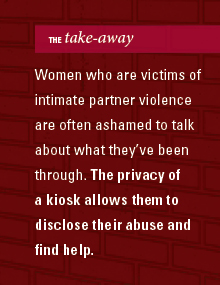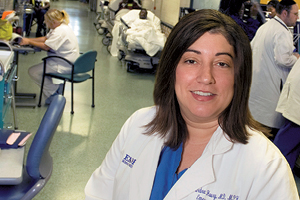Behind closed doors
By Debra Houry

 |
During my residency training in emergency medicine, I routinely encountered patients with injuries that could have been prevented. I realized then that asking about safe storage of firearms, substance use, violence in the home, and other health-risk behaviors could help my patients after they left the emergency department. I also recognized that emergency physicians are often the only health providers with whom some patients interact. That is particularly true of victims of intimate partner violence, what used to be known as "domestic violence."
One of the first patients who opened my eyes to this challenge was a young woman who had climbed through a window to leave a locked apartment and seek medical care after her partner left for work. She was embarrassed to talk about her situation. In fact, she failed to disclose the source of her injuries initially. When she did open up to me, I learned that she had been subjected to repeated, brutal beatings for months. Tragically, she thought she had done something to deserve the treatment. I was the first provider who had seen her since she had been in this abusive relationship.
Years later, I encountered a young mother who had sustained facial injuries and a wrist fracture from what she called a "fall." When I questioned her further, she admitted that her boyfriend had caused the injuries. Still she was worried about what the boyfriend would do if she told anyone about the abuse, particularly because they had a child together. She came to the emergency department only because of the severity of her injuries.
More recently, I saw a woman with chronic abdominal pain. Only after further questioning did I discover that her partner had raped her several months earlier. She had told no one, neither family nor friends, about the assault. These cases and more confirm for me that we need to screen women for partner violence in clinical settings.
Intimate partner violence is not a problem that happens outside our social circles or to others. Given that 25% of women have experienced physical or emotional abuse by a partner at some point, I am certain that if not you personally, then someone else in your life—a neighbor, a co-worker, a family member—has experienced intimate partner violence. Each day in the United States, three women are killed by a partner, and 24 people each minute are victims of rape, physical violence, or stalking by an intimate partner.
Neither is intimate partner violence a one-time occurrence. The cycle of violence continues, escalates, and can ensnare others such as children. The health consequences are severe for abused women who have higher rates of hypertension, mental health symptoms, substance abuse, and infections than do women who have not been subjected to intimate partner violence. Further, victims lose 8 million days of paid work a year, which equals about 32,000 full-time jobs. Adding insult to injury, children who are the silent witnesses are more likely to become victims or perpetrators of partner violence if they are exposed to violence at home.
Although the Joint Commission on Accreditation of Healthcare Organizations requires hospitals to have policies and procedures in place to identify victims of partner violence and refer them to help, most clinicians are unaware of available resources, and they may fail to routinely screen for partner violence.
The Institute of Medicine recently released recommendations that preventive care should include screening and counseling for all women and adolescent girls for interpersonal violence. That sounds simple, but…
25% of women have experienced physical or emotional abuse by a partner at some pointEach day in the United States, three women are killed by a partner24 people each minute are victims of rape, physical violence, or stalking by an intimate partner |
Reducing stigma and shame
Busy and chaotic clinical environments are challenging environments in which to ask sensitive questions about intimate partner violence. To further complicate the situation, many patients are embarrassed to disclose the fact that they’ve been abused, or they may have family members at their bedside who are unaware of the abuse. In addition, many survivors of intimate partner violence may see their doctor or nurse after their obvious injuries have healed. Instead they often seek care for depression, headaches, substance abuse, or other secondary complaints that doctors may fail to connect immediately to ongoing patterns of abuse.
With these observations in mind, our research team at the Emory Center for Injury Control developed an innovative way to help these women. We started a violence screening initiative that women can access privately and easily through kiosks in hospital waiting rooms. These kiosks tailor resource lists based on the patient’s response, ensuring that the patient receives information on specific conditions and taking this step out of the hands of a busy clinician who may fail to ask routinely about abuse. Incorporating this technology is an inexpensive way to help patients who might otherwise fail to disclose abuse or other issues such as mental health symptoms or substance abuse problems.
For our original study, funded by the CDC and the NIH, we placed kiosks in the waiting room of the emergency department at Grady Memorial Hospital. Any patient who disclosed partner violence through a series of questions loaded onto the kiosk received an auto-generated list of resources. Of the 2,134 patients in a recent relationship, we found that 22% had experienced abuse in the past year. Among those we reached for follow-up at three months, 35% had contacted a community resource for partner violence.
Victims lose 8 million days of paid work a year, which equals about 32,000 full-time jobsOf the 2,134 patients in a recent relationship, we found that 22% had experienced abuse in the past yearAmong those reached for follow-up at three months, 35% had contacted a community resource for partner violence |
With additional funding through the Avon Foundation, we replicated this work in emergency departments at Emory University Hospital (EUH) and EUH Midtown. Women at these sites reported similar rates of recent abuse and, like the women at Grady, they followed through to contact the suggested resources.
Although these kiosks have yielded promising results, we used a real person from our project staff rather than relying on technology to discuss results with patients. With funding from the Verizon Foundation, we are now studying how these kiosks can operate in an unmanned environment to make the system even more cost-effective.
I have seen how screening for partner violence and referral to community resources can save lives. I appreciate how effective these kiosks have been in reducing stigma and shame around abuse and how they’ve made it safe for patients to disclose their intimate partner violence issues. However, I also know that this solution is just a Band-Aid on our larger problem.
Our society needs to focus on preventing violence before it occurs and to refrain from normalizing these behaviors. Violence against women is a systemic problem in the United States and worldwide. It’s past time for our country to do something about intimate partner violence. It’s time for us to take the lead in preventing the cycle of violence from continuing. EM
Want more?The Georgia domestic violence (DV) hotline is 1-800-33-HAVEN, and the national DV hotline is 1-800-799-SAFE.To contribute to Houry’s efforts to curb intimate partner violence through the Emory Center for Injury Control, please contact Development Director Stacia Brown at 404-727-9030 or stacia.brown@emory.edu. |
Related Links
"Center for Injury Control commemorates 20th anniversary"






